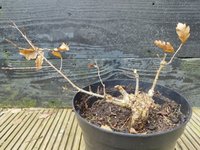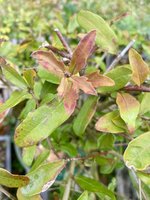Arizona bonsai
Shohin
Nice tree & beer choice
The snake.Oak I gathered as a seedlings about 8 years ago waking up. View attachment 510638View attachment 510639
Unusually upright growth . This looks a lot like Quercus robur Fastigiata?English Oak. Just growing. Next year may be the year I finally chop it down. Maybe. I may also let it simply grow more. New branches are nicely developing low on the trunk with many dormant buds awaiting the right time to open. The trunk base at the soil level is 3” (7.5cm). More buds have opened on branches in places closer to the trunk since this photo. Several new branches are developing from buds above the newest growth. The end of July usually produces this flush of growth.View attachment 500395View attachment 500397View attachment 500398
Very well be that species of Oak. I posted at the higher classification of identity as an English Oak because I was not certain. And, saying the English Oak classification felt better than just saying….Oak Tree. I had not researched deeper into the specifics yet. It is an oak though and has fabulous acorns. There are a few oaks that tend to grow more upright than spreading. Thank you!…..for helping narrow down the specific species. I have more tree confidence now with your identification. This identification should help me when I begin chopping and working on the Quercus Robar Fastigiata…..Oak Tree. I feel more encouraged now with deeper tree identity.Unusually upright growth . This looks a lot like Quercus robur Fastigiata?




So you are in or near Fryslân? Depending on location maybe Oranjewoud or the Kuinderbos are close? De Fryske Marren also have a lot of beautiful starter material.hekkelen
Man, I really enjoy lurking in this section. After exploring the rest of the forum I finally feel confident enough to post something myself after trying something new.
I live on the countryside where there is not much of forest patches so finding some good yamadori is difficult. Currently I am staying in an area where there is a lot of oak, beech, alder and some birch. Now I've found two Quercus Robur that i've collected as yamadori.
View attachment 521357
This one was found in a ditch. Completely butchered for several years. My guess is that it has been cut several times by a farmer who is cleaning the waterplants out of a ditch. I do not know how to call it. Around here we call it "hekkelen". There you go; the dutch word of the day. Never too old to learn
View attachment 521359
Sorry for the not completly crisp photo but here's a close-up of the trunk.
Im not entirely sure what i'm going to do with it. I've cut some branches that where dead, pointing directly down or up or where crossing other branches. I leave it to rest and man I hope it survives.
Then there is this;
View attachment 521360
I've found this in a ditch as well. I really liked the movement of the trunk and the position of the primary branches. To me it looks really promising as a bonsai. So today I collected this one as well.
View attachment 521361
Again cut back some long shoots, dead branches and leave it to it for the coming year or three. Maybe eventually chop it just above the third primary branch and make that the new apex.
Both of them had a very long taproot. Inspected it and cut it back to where most of the root hairs started to grow. For now I am not worried about wiring since I sincerely hope they'll make it. The rootball wasn't really big to begin with when I dug them up. They have some nice budding so I'll keep a close eye on them in spring. Can't wait.
Does anyone know how to notice the tree is dead before they make it to spring? Or is spring the earliest moment to notice the tree made it or not.
Fryslân! Exactly! I live near Leeuwarden so it's mostly grass and Salix along the ditchesSo you are in or near Fryslân? Depending on location maybe Oranjewoud or the Kuinderbos are close? De Fryske Marren also have a lot of beautiful starter material.
You can see if they are still holding up by checking the buds. There should be this waxy appearance, and a radiant colour shining from within, but if the surface colour is dull they're likely to be dead. In about 2.5 to 3 months you should see some swelling starting, if that doesn't happen your first chance to see if it lives will probably budbreak.
Possible to keep on heating pad until Spring? Last Winter used one under two bareroot Persimmon seedlings sent in Dec. Box said kept soil 20 degrees F above surrounding temp. Seemed to work well as they did very well this seasonMan, I really enjoy lurking in this section. After exploring the rest of the forum I finally feel confident enough to post something myself after trying something new.
I live on the countryside where there is not much of forest patches so finding some good yamadori is difficult. Currently I am staying in an area where there is a lot of oak, beech, alder and some birch. Now I've found two Quercus Robur that i've collected as yamadori.
View attachment 521357
This one was found in a ditch. Completely butchered for several years. My guess is that it has been cut several times by a farmer who is cleaning the waterplants out of a ditch. I do not know how to call it. Around here we call it "hekkelen". There you go; the dutch word of the day. Never too old to learn
View attachment 521359
Sorry for the not completly crisp photo but here's a close-up of the trunk.
Im not entirely sure what i'm going to do with it. I've cut some branches that where dead, pointing directly down or up or where crossing other branches. I leave it to rest and man I hope it survives.
Then there is this;
View attachment 521360
I've found this in a ditch as well. I really liked the movement of the trunk and the position of the primary branches. To me it looks really promising as a bonsai. So today I collected this one as well.
View attachment 521361
Again cut back some long shoots, dead branches and leave it to it for the coming year or three. Maybe eventually chop it just above the third primary branch and make that the new apex.
Both of them had a very long taproot. Inspected it and cut it back to where most of the root hairs started to grow. For now I am not worried about wiring since I sincerely hope they'll make it. The rootball wasn't really big to begin with when I dug them up. They have some nice budding so I'll keep a close eye on them in spring. Can't wait.
Does anyone know how to notice the tree is dead before they make it to spring? Or is spring the earliest moment to notice the tree made it or not.



possibly a hybridized form of laurel oak. Oaks breed indiscriminately. Likely cross bred with live oaks.Picked up a new oak a few days ago. As I was paying for it I kept calling it a Laurel Oak and the guy helping never corrected me or anything. I got home and it definitely doesn't look like my live oaks but does seem just a bit different from my other Laurel. I checked my receipt and he wrote "sale oak" lol. I'm including a picture of some new foliage and a close up of the trunk if anyone is able to confirm Laurel Oak.
View attachment 524480View attachment 524479View attachment 524481
That makes sense. Thanks.possibly a hybridized form of laurel oak. Oaks breed indiscriminately. Likely cross bred with live oaks.
Just for the heck of it, I ran it through the PictureThis app and it came up with "Water Oak".Picked up a new oak a few days ago. As I was paying for it I kept calling it a Laurel Oak and the guy helping never corrected me or anything. I got home and it definitely doesn't look like my live oaks but does seem just a bit different from my other Laurel. I checked my receipt and he wrote "sale oak" lol. I'm including a picture of some new foliage and a close up of the trunk if anyone is able to confirm Laurel Oak.
View attachment 524480View attachment 524479View attachment 524481
The Apple ID app said Chapman. Google lens came up with several different types of oak including water, chapman and laurel. I am going to go with laurel. Come to think of it Wigerts only carries Live Oak and Laurel Oak, I should have known already.Just for the heck of it, I ran it through the PictureThis app and it came up with "Water Oak".
